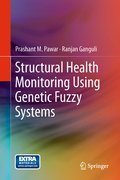
Structural health monitoring using genetic fuzzy systems
Pawar, Prashant M.
Ganguli, Ranjan
Structural health monitoring (SHM) has emerged as a prominent research area in recent years owing to increasing concerns about structural safety, and the need to monitor and extend the lives of existing structures. Structural Health Monitoring Using Genetic Fuzzy Systems elaborates the process of intelligent SHM development and implementation using the evolutionary system. The use of a genetic algorithm automates the development of the fuzzy system, and makes themethod easy to use for problems involving a large number of measurements, damage locations and sizes; such problems being typical of SHM. The ideas behind fuzzy logic, genetic algorithms and genetic fuzzy systems are also explained. The functionality of the genetic fuzzy system architecture is elucidated within a case-study framework, covering: SHM of beams; SHM of composite tubes; and SHM of helicopter rotor blades. Structural Health Monitoring Using Genetic Fuzzy Systems will be useful for aerospace, civil and mechanical engineers working with structures and structured components. It will also be useful for computer scientists and applied mathematicians interested in the application of genetic fuzzy systems to engineering problems. Demonstrates the application of genetic fuzzy systems to engineering problems, which will be of interest to computer scientists and applied mathematicians. Provides the reader with information on the use of genetic fuzzy systems as a computational tool for solving structural health monitoring problems. Examples provided in this book assist the reader in developing genetic fuzzy systems for new structures and aerospace systems. INDICE: Introduction. Genetic Fuzzy Systems. SHM of Beams. SHM of Composite Beams. SHM of Helicopter Rotors.
- ISBN: 978-0-85729-906-2
- Editorial: Springer London
- Encuadernacion: Cartoné
- Páginas: 136
- Fecha Publicación: 30/09/2011
- Nº Volúmenes: 1
- Idioma: Inglés
